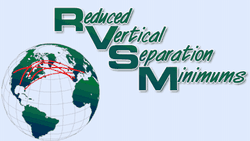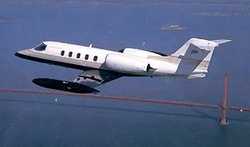Mon, Jan 24, 2005
An ANN Reader Talks About The Downside of RVSM
By Mark Conner, Chief Pilot, Dycom Industries, Inc.
 Most corporate operators see this as
a winning move for the airlines and a financial burden to us. True
that the airlines will save money by cruising at more efficient
altitudes but the cost to my corporation is significant with little
reward.
Most corporate operators see this as
a winning move for the airlines and a financial burden to us. True
that the airlines will save money by cruising at more efficient
altitudes but the cost to my corporation is significant with little
reward.
The cost to conform our late model LearJet 35A was over $180,000 in
direct cost. If one includes the cost of nearly a month of downtime
for the modification, that number might easily be doubled. We
will see little if any reward as our cruise is usually above
RVSM altitudes. Moreover, the FAA placed a huge burden on part 91
operators to submit a manual covering operations and maintenance
procedures. This should have been covered by the SCT's continued
airworthiness instructions and a new FAR 91 regulation covering
RVSM operations. This time and expense to small flight department
is not insignificant.
 Many turboprop operators have chosen
not to spend the money to modify their aircraft. They will now be
forced to operate at inefficient altitudes. Moreover, the weather
they used to top will now force either a circumnavigation or a
cancellation of the flight. This hurts general aviation as it makes
planes more expensive to own, or operate and reduces the utility of
a huge number of planes.
Many turboprop operators have chosen
not to spend the money to modify their aircraft. They will now be
forced to operate at inefficient altitudes. Moreover, the weather
they used to top will now force either a circumnavigation or a
cancellation of the flight. This hurts general aviation as it makes
planes more expensive to own, or operate and reduces the utility of
a huge number of planes.
Many operators of older jets have found conformity to RVSM cost
prohibitive. There is a whole generation of older LearJets,
Citations, Hawkers, and Saberliners that will be doomed. Their
values have steadily dropped and operating costs have risen due to
high fuel flows. For example, older Lear 24 can be had for little
more than the price of a good Navajo with an operating cost over
$1500 per hour. This made them ideal for owners who operated
infrequently and were willing to foot the bill for fuel as long as
they didn't have to face a multimillion-dollar debt service. These
planes are destined to be sold to third world countries for little
more than their salvage values.

RVSM has not been a friend to General Aviation. It is yet
another move toward the restrictive type of airspace that plagues
Europe. I cannot help but ask how long until the rest of General
Aviation is as restricted and costly as it is now in Europe. How
long before legislators, in the name of national security and
airline profitability, add the next level of bricks on the tomb of
General Aviation?
More News
He Attempted To Restart The Engine Three Times. On The Third Restart Attempt, He Noticed That Flames Were Coming Out From The Right Wing Near The Fuel Cap Analysis: The pilot repor>[...]
Make Sure You NEVER Miss A New Story From Aero-News Network Do you ever feel like you never see posts from a certain person or page on Facebook or Instagram? Here’s how you c>[...]
From 2009 (YouTube Edition): Leading Air Show Performers Give Their Best Advice for Newcomers On December 6th through December 9th, the Paris Las Vegas Hotel hosted over 1,500 air >[...]
Aero Linx: NASA ASRS ASRS captures confidential reports, analyzes the resulting aviation safety data, and disseminates vital information to the aviation community. The ASRS is an i>[...]
“For our inaugural Pylon Racing Seminar in Roswell, we were thrilled to certify 60 pilots across our six closed-course pylon race classes. Not only did this year’s PRS >[...]
 NTSB Final Report: Rutan Long-EZ
NTSB Final Report: Rutan Long-EZ ANN FAQ: Turn On Post Notifications
ANN FAQ: Turn On Post Notifications Classic Aero-TV: ICAS Perspectives - Advice for New Air Show Performers
Classic Aero-TV: ICAS Perspectives - Advice for New Air Show Performers ANN's Daily Aero-Linx (06.28.25)
ANN's Daily Aero-Linx (06.28.25) Aero-News: Quote of the Day (06.28.25)
Aero-News: Quote of the Day (06.28.25)





